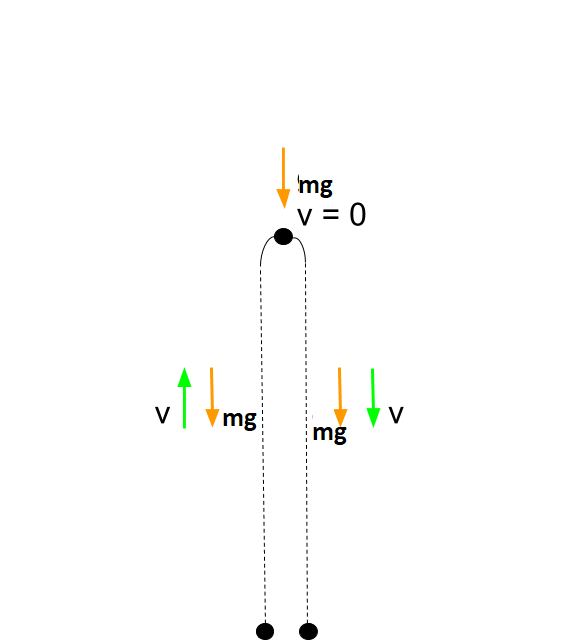
A pebble of mass 0.5g is thrown vertically upwards. Give the direction and magnitude of the net force on the pebble,
(a) During its upwards motion
(b) During its downwards motion
(c) At the highest point where it is momentarily at rest.
Do your answers change if the pebble was thrown at an angle of 45 with the horizontal direction? Ignore air resistance.
Answer
558.9k+ views
Hint: A pebble is thrown vertically upwards. Some force would have been required to toss the pebble upwards. After that initial push, throughout the motion, the pebbled will experience its own weight as a force. We know that the force of the weight is given by the formula given below
Formula used:
\[W=m\cdot g\]
Complete answer:
A pebble is thrown vertically upwards. Some force would have been required to toss the pebble upwards. After that initial push, throughout the motion, the pebbled will experience its own weight as a force.
We know that the force of the weight is given by
\[W=m\cdot g\]
The mass of the pebble is given, then the force it experiences will be given as
\[\begin{align}
& W=m\cdot g \\
& \Rightarrow W=0.5\times 10 \\
& \Rightarrow W=5N \\
\end{align}\]
So, the pebble will experience a force of 5 N, this force will be in the downward direction.

(a) During its upwards motion
The net velocity of the pebble will be in upwards direction and the pebble will experience a net force of 5N in the downward direction.
(b) During its downwards motion
The net velocity of the pebble will be in downwards direction and the pebble will experience a net force of 5N in a downward direction.
(c) at the highest point where it is momentarily at rest.
The net velocity of the pebble will be 0 and the pebble will experience a net force of 5N in a downward direction.
There will be no change if the pebble was thrown at an angle of 45 with the horizontal direction. The motion of the pebble will be identical vertically, the only change will be that the pebble will have a horizontal component to its velocity.
Note:
The motion of a projectile is quite similar to the motion of a body having one-dimensional motion in a vertical plane. Both of these bodies have only acceleration due to gravity in a vertically downward direction. The projectile has a horizontal component to its velocity but no acceleration in the horizontal direction and thus the horizontal remains constant throughout the motion of the body.
Formula used:
\[W=m\cdot g\]
Complete answer:
A pebble is thrown vertically upwards. Some force would have been required to toss the pebble upwards. After that initial push, throughout the motion, the pebbled will experience its own weight as a force.
We know that the force of the weight is given by
\[W=m\cdot g\]
The mass of the pebble is given, then the force it experiences will be given as
\[\begin{align}
& W=m\cdot g \\
& \Rightarrow W=0.5\times 10 \\
& \Rightarrow W=5N \\
\end{align}\]
So, the pebble will experience a force of 5 N, this force will be in the downward direction.

(a) During its upwards motion
The net velocity of the pebble will be in upwards direction and the pebble will experience a net force of 5N in the downward direction.
(b) During its downwards motion
The net velocity of the pebble will be in downwards direction and the pebble will experience a net force of 5N in a downward direction.
(c) at the highest point where it is momentarily at rest.
The net velocity of the pebble will be 0 and the pebble will experience a net force of 5N in a downward direction.
There will be no change if the pebble was thrown at an angle of 45 with the horizontal direction. The motion of the pebble will be identical vertically, the only change will be that the pebble will have a horizontal component to its velocity.
Note:
The motion of a projectile is quite similar to the motion of a body having one-dimensional motion in a vertical plane. Both of these bodies have only acceleration due to gravity in a vertically downward direction. The projectile has a horizontal component to its velocity but no acceleration in the horizontal direction and thus the horizontal remains constant throughout the motion of the body.
Recently Updated Pages
In an electrolytic cell current flows from ACathode class 11 chemistry CBSE

What is the difference between Coal and Coke class 11 chemistry CBSE

Define what is electrolysis and the process of ele class 11 chemistry CBSE

What is perisperm Where does it locate class 11 biology CBSE

A heavy but uniform rope of length L is suspended from class 11 physics CBSE

How many sixdigit numbers are there in which no digit class 11 maths CBSE

Trending doubts
10 examples of friction in our daily life

One Metric ton is equal to kg A 10000 B 1000 C 100 class 11 physics CBSE

Difference Between Prokaryotic Cells and Eukaryotic Cells

1 Quintal is equal to a 110 kg b 10 kg c 100kg d 1000 class 11 physics CBSE

State the laws of reflection of light

Explain zero factorial class 11 maths CBSE




